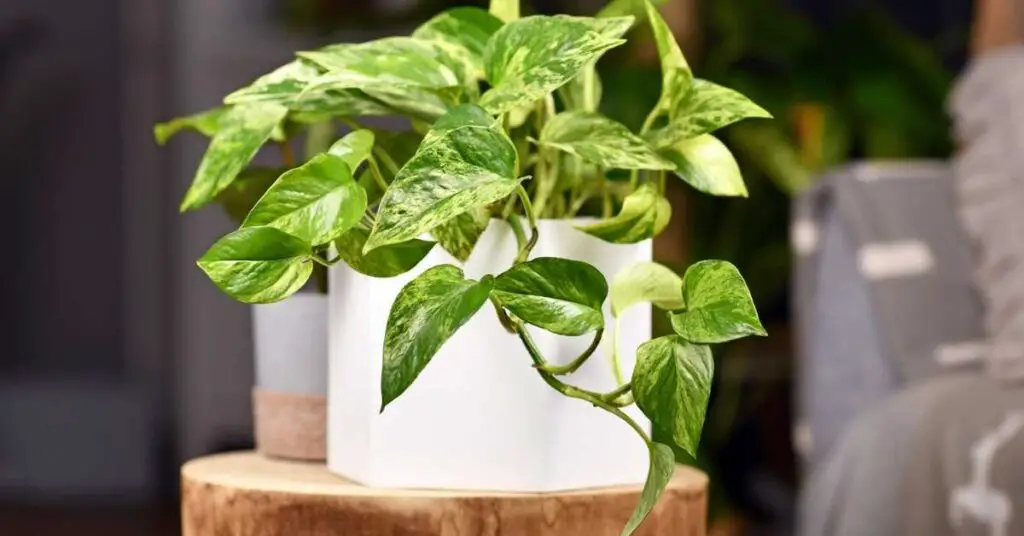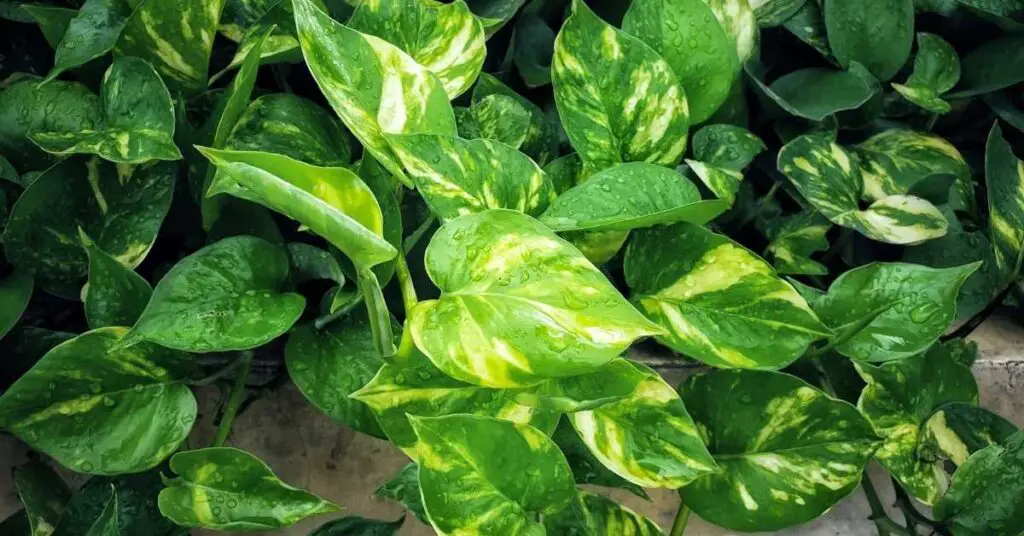Do you dream of having a lush, vibrant garden that feels like your own personal oasis? Well, guess what? Your pothos plant can join in on the summer fun too!
Just like a cool breeze on a sweltering day, taking your pothos outside in the summer can be a refreshing experience.
Not only will it add a touch of natural beauty to your outdoor space, but it can also thrive in the warm, sunny weather.
So, if you’re longing for a sense of belonging with nature and want to create a cozy outdoor haven, keep reading to learn all about the benefits of having your pothos outside during the summer months and how to care for it like a pro.
Key Takeaways
- Outdoor care for pothos promotes improved growth and a healthier plant.
- Pothos thrives in well-draining soil rich in organic matter, and proper pruning techniques maintain health and appearance.
- Pothos requires bright, indirect sunlight and an ideal temperature range between 60°F and 85°F.
- Regular deep watering, moderate to high humidity levels, and protection against pests and diseases are crucial for outdoor pothos care.
Benefits of Outdoor Pothos Care
If you take your Pothos outside during the summer, you’ll reap the benefits of improved growth and a healthier plant. Outdoor Pothos care offers several advantages over indoor care, making it an appealing option for those looking to expand their plant collection. When comparing outdoor pothos to indoor pothos, it becomes evident that outdoor care is easier and more beneficial.
Outdoor pothos plants have the advantage of receiving natural sunlight, which is essential for their growth and overall health. Sunlight provides the necessary energy for photosynthesis, allowing the plant to produce food and grow vigorously. Additionally, outdoor plants benefit from better air circulation, reducing the risk of pests and diseases. The natural environment also provides a more stable temperature range, which is crucial for optimal growth.
Another advantage of outdoor care is the opportunity to propagate pothos plants for a larger collection. Propagation is a simple and cost-effective way to increase your plant stock. By taking stem cuttings from the outdoor pothos and placing them in water or a well-draining soil mix, you can encourage root development and grow new plants. This method allows you to expand your plant collection and share the joy of gardening with others.

Choosing the Right Outdoor Location
To ensure the optimal growth and health of your outdoor Pothos plants during the summer, it’s crucial to choose the right location. When selecting a spot for your Pothos, it’s important to consider the ideal soil conditions and proper pruning techniques.
For finding the ideal soil conditions, Pothos thrives in well-draining soil that’s rich in organic matter. It’s recommended to mix equal parts of potting soil, perlite, and peat moss to create a suitable growing medium. This will provide the necessary nutrients and moisture retention while preventing waterlogging, which can lead to root rot.
Proper pruning techniques are essential for maintaining the health and appearance of your outdoor Pothos. Regular pruning helps to control the size and shape of the plant while encouraging new growth. It’s advised to trim back any dead or damaged leaves, as well as any vines that have become too long or unruly. This will promote healthy growth and prevent the plant from becoming overcrowded.
Essential Sunlight and Temperature Requirements
Ensure that your outdoor Pothos plants receive the necessary sunlight and maintain the appropriate temperature levels during the summer. Pothos plants thrive in bright, indirect sunlight, making them ideal for outdoor spaces with partial shade. Direct sunlight can scorch the leaves, causing them to turn yellow and wilt. Therefore, it’s crucial to provide your Pothos plants with the right amount of sunlight to promote healthy growth.
When it comes to temperature requirements, Pothos plants prefer warm and humid conditions. They can tolerate a wide range of temperatures, but they thrive best in temperatures between 60°F (15°C) and 85°F (29°C). Extreme heat or cold can stress the plant and inhibit its growth. It’s important to protect your Pothos plants from frost and freezing temperatures, as they’re sensitive to cold.
To ensure that your outdoor Pothos plants receive the optimal sunlight and temperature levels, consider placing them in a location that provides partial shade during the hottest parts of the day. This will shield them from intense sunlight and help regulate the temperature around the plant. Additionally, monitor the weather and take necessary precautions such as bringing the plants indoors during extreme weather conditions.
Watering and Humidity Tips for Outdoor Pothos
You should regularly water your outdoor Pothos plants and maintain the proper humidity levels to ensure their health and vitality during the summer.
Outdoor Pothos plants require consistent watering techniques to thrive in the heat. It’s recommended to water them deeply once a week, allowing the water to penetrate the soil and reach the roots. However, the frequency of watering may vary depending on factors such as temperature, humidity levels, and soil moisture. To determine if your Pothos plants need watering, simply check the top inch of soil. If it feels dry, it’s time to water.
In addition to watering, maintaining the right humidity levels is crucial for the health of your outdoor Pothos plants. Pothos plants thrive in moderate to high humidity levels, ideally between 50% to 70%. To create an environment with suitable humidity, you can mist the leaves with water using a spray bottle. Also, placing a tray filled with water near the plants can help increase humidity levels.
Proper watering and humidity levels are essential for the overall well-being of your outdoor Pothos plants. By following these care tips, you can ensure that your plants flourish and remain vibrant throughout the summer season.

Protecting Your Pothos From Pests and Diseases
To maintain the health of your outdoor Pothos plants during the summer, it’s important to take proactive measures in protecting them from pests and diseases. Implementing effective pest control and disease prevention strategies will ensure that your Pothos plants thrive in the outdoor environment.
Here are some key steps you can take:
Pest Control:
- Regularly inspect your plants for signs of pests such as aphids, mealybugs, or spider mites.
- Use insecticidal soap or neem oil to treat infestations, following the manufacturer’s instructions.
- Encourage beneficial insects like ladybugs or lacewings to help control pest populations naturally.
Disease Prevention:
- Provide adequate spacing between plants to promote airflow and reduce the risk of fungal diseases.
- Avoid overhead watering to prevent the spread of fungal spores.
- Remove any diseased or damaged foliage promptly to prevent the spread of infection.
Preparing Your Pothos for Indoor Transition
Once the summer season comes to an end, it’s important to properly prepare your Pothos plants for the transition back indoors. The transitioning process from outdoor to indoor conditions can pose potential challenges for your Pothos, but with the right approach, you can ensure a smooth and successful shift.
First and foremost, it’s crucial to gradually acclimate your Pothos to the indoor environment. Sudden changes in temperature, light, and humidity can shock the plant and lead to stress or even damage. Begin by bringing your Pothos inside for shorter periods, gradually increasing the duration over a week or two. This allows the plant to adjust slowly to the lower light levels and controlled climate indoors.
During this transition, it’s important to monitor the moisture levels of the soil. Indoor conditions tend to be drier than outdoor environments, so you may need to adjust your watering routine accordingly. Be mindful not to overwater, as this can lead to root rot and other issues. On the other hand, make sure the plant is receiving adequate humidity by using a humidifier or placing it near a tray of water.
Additionally, it’s crucial to inspect your Pothos for any pests that may have hitchhiked indoors. Common pests include mealybugs, spider mites, and aphids. These can quickly multiply and cause damage to your plant if left unchecked. Regularly inspect the leaves, stems, and soil for any signs of infestation and take appropriate measures to eliminate the pests.
Frequently Asked Questions
How Often Should I Fertilize My Outdoor Pothos?
You should fertilize your outdoor pothos every 2-4 weeks during the growing season. Some of the best outdoor pothos varieties include ‘Marble Queen’ and ‘Neon’. Regular fertilizing will help promote healthy growth and vibrant foliage.
Can Pothos Survive in Extreme Heat or Cold?
Pothos can tolerate some extreme temperatures, but it will require proper care. Outdoor pothos should be protected from direct sunlight and cold drafts. Provide adequate water and ensure the soil is well-drained. Regularly check for pests and adjust care accordingly.
When it gets cold it will need to be protected from the wind and extreme cold. If you live in an area where you do not get frost then you could leave it outside but if you live where frost and extreme cold is the normal – it is best if you bring it inside for the winter.
Are There Any Specific Varieties of Pothos That Are Better Suited for Outdoor Growth?
Certain varieties of Pothos are better suited for outdoor growth due to their ability to tolerate varying light conditions and temperature fluctuations. These varieties possess traits that enhance their resilience and adaptability in an outdoor environment.
Can Pothos Be Grown Directly in the Ground or Does It Require a Pot?
You can grow pothos directly in the ground or in a pot. It is possible to grow pothos outdoors in the summer. There are pros and cons to both methods.
How Do I Protect My Outdoor Pothos From Strong Winds or Storms?
To protect your outdoor pothos from strong winds or storms, use methods for securing it in windy conditions such as staking or tying it to a sturdy support. Additionally, provide shelter or cover to shield it from heavy rain and hail.
Conclusion
In conclusion, outdoor care for pothos during the summer offers numerous benefits including increased growth, vibrant foliage, and improved air purification. By selecting an appropriate location with adequate sunlight and temperature conditions, providing proper watering and humidity levels, and protecting the plant from pests and diseases, you can ensure the health and vitality of your pothos.
As summer comes to an end, it’s important to prepare your pothos for a smooth transition back indoors to maintain its thriving state.


